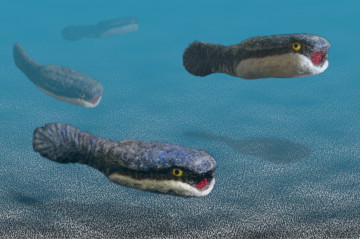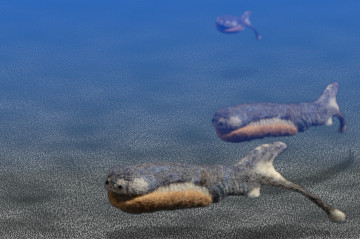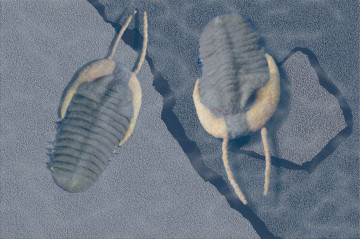- Cambrian
- Ordovician
- Silurian
- Devonian
- Carboniferous
- Permian
Ordovician Period
From 485.4 million year to 443.8 million years ago.
The Ordovician period was named after the Welsh Celtic tribe.
During the Ordovician, Godowana locating in the southern hemisphere, which included the continents of Africa, Antarctica, Australia, and South America, was shifting further south, and the other smaller landmass started to gather each other. Eventually, Gondwana reached to the South pole and stayed there until the next Silurian. The north hemisphere were almost ocean. Sea level was so high that the shallow sea was spread around Gondwana.
From the Lower to Middle Ordovician was warm and humid. The trilobites which overcame the damage on the end of the Cambrian flourished, and the other invertebrates, for examples, nautiloids, graptolites, bryozoans, crinoids (sea-lily), also became more diverse. In the vertebrates, so-called Ostracoderms, armored jawless fishes developed (e.g. Arandaspis, Sacabambaspis). The anterior half of its body was covered with bony shields and the mouth opened on ventral had no jaws. Conodonts, primitive vertebrates which have been found as a numerous tooth-like microfossils also showed evolutionay radiation.
The first primitive plants began to make inroads into the land, subsequently, some arthropods were followed.
Due to the drift of Gongowana to the South Pole during the Upper Ordovician, the massive glaciation were progressed on the central area of Gondwana which corresponds to the present Africa. As a result, the sea levels fell down and the shallow sea, which nurtured many lives, drying up. Furthermore, a numerous species were eliminated. It is thought that this mass extinction were the second large one in the history of life.
References:
- National Geographics
- Pappas S (2013) Paleozoic Era: Facts & Information Live Sience June 20, 2013
- UCMP - University of California Museum of Paleontolgy - (Legacy Exhibits Online, Tour of Geologic TIme)
- International Commission on Stratigraphy - International Chronostratigraphic Chart v 2023/06.



